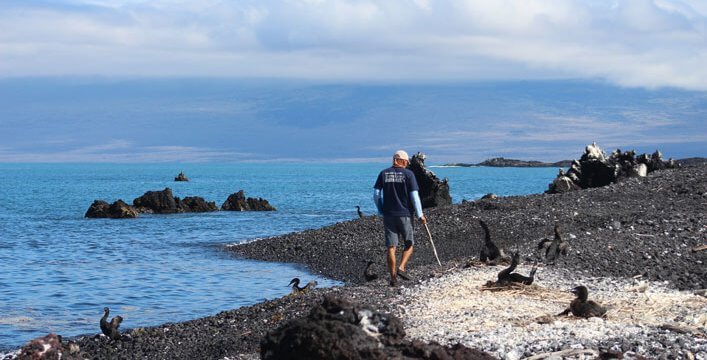
Written in collaboration with Gustavo Jiménez-Uzcategui.
Galapagos penguins (Spheniscus mendiculus) and non-flying cormorants (Phalacrocorax harrisi) are two endemic species of the Galapagos Islands. The penguins can be found commonly in Isabela, Fernandina, Bartolome and Floreana since they are reproductive zones. However, individuals have been registered in Santa Fe, Santiago, Rabida, Baltra, Daphne and the north and south of Santa Cruz. Non-flying cormorants are found only on the shores of Isabela and Fernandina.
Both species are vulnerable to both natural and anthropogenic impacts. Among its greatest threats are: climate change as water temperature increases, food decreases; and on the other hand, introduced species such as cats and rats that feed on adults, eggs and juvenile individuals. For this reason, the Charles Darwin Foundation (CDF), together with the Galapagos National Park Directorate (DPNG), performs three annual monitoring periods with the objective of knowing the status of the population of the two species in order to take the necessary conservation measures. Monitoring allows the determination of survival, mortality and reproduction of penguins and non-flying cormorants by tagging individuals, their nests and a census along the west coast of Isabela and the east coast of Fernandina to estimate the number and compare it with previous censuses.

On Monday, November 7, we left to the west of the archipelago to perform the last monitoring of the year 2016. We began the tour in Caleta Iguana, a bay to the south-west of Isabela Island where 14 penguins were tagged. To tag these animals they are captured, the measurements of the beak and wing, weight, cardiac, respiratory and temperature readings are taken and finally a pit-tag with a number is placed in one of its legs; this is placed in the subcutaneous part and has no negative impact on individuals. Before their release, red lines are made in the chest with a marker to not recapture them.

On the second day, we carried out the first of four censuses from Punta Essex to Playa de los Perros, where we found 101 penguins, 79 cormorants and hundreds of individuals of other species such as blue-footed boobies, marine iguanas, sea turtles, pelicans, frigates, among others in smaller quantity. The census consists of crossing the coast identifying and registering all the animals present in the area, giving priority to the target species. The following days we continued with the tagging and censuses in Puerto Pajas, Albermarle Point (Isabela), Marielas Inlets, Punta Mangle and Punta Espinoza (Fernandina).

How can we differentiate the age of these species by capturing and tagging them? In the case of penguins, juveniles have white cheeks while adults have black cheeks and usually females are smaller than males. In the case of cormorants there is a clear difference between adults and juveniles, adults have turquoise eyes while juveniles have black eyes, adults are dark brown and juveniles are black.

These species of birds have unique characteristics because unlike other birds they cannot fly, so that their wings working as fins, along with their short but strong legs and webbed feet, allow them to swim and dive to get their food. Penguins feed on different species of fish in coastal waters, reaching up to a depth of 50 meters, while cormorants feed on octopuses, eels, fish and crustaceans from coastal areas and can dive more than 70 meters deep. Both species can lay two to three eggs, which take 30-35 days to hatch.

As part of the team were park rangers of the GNPD who captured individuals and became involved in the various activities, in addition to the crew of the Queen Mabel boat that supported us throughout the trip.
This project is led by DVM Gustavo Jiménez-Uzcategui of the FCD, and is developed thanks to the support of: Galapagos Conservancy Trust, Lindblad National Geographic, Penguin Fund Japan, Mr. Seishi Sakamoto, Blue Planet Film, with the collaboration of the University San Francisco of Quito, Colorado State University, University of Missouri, among others.




